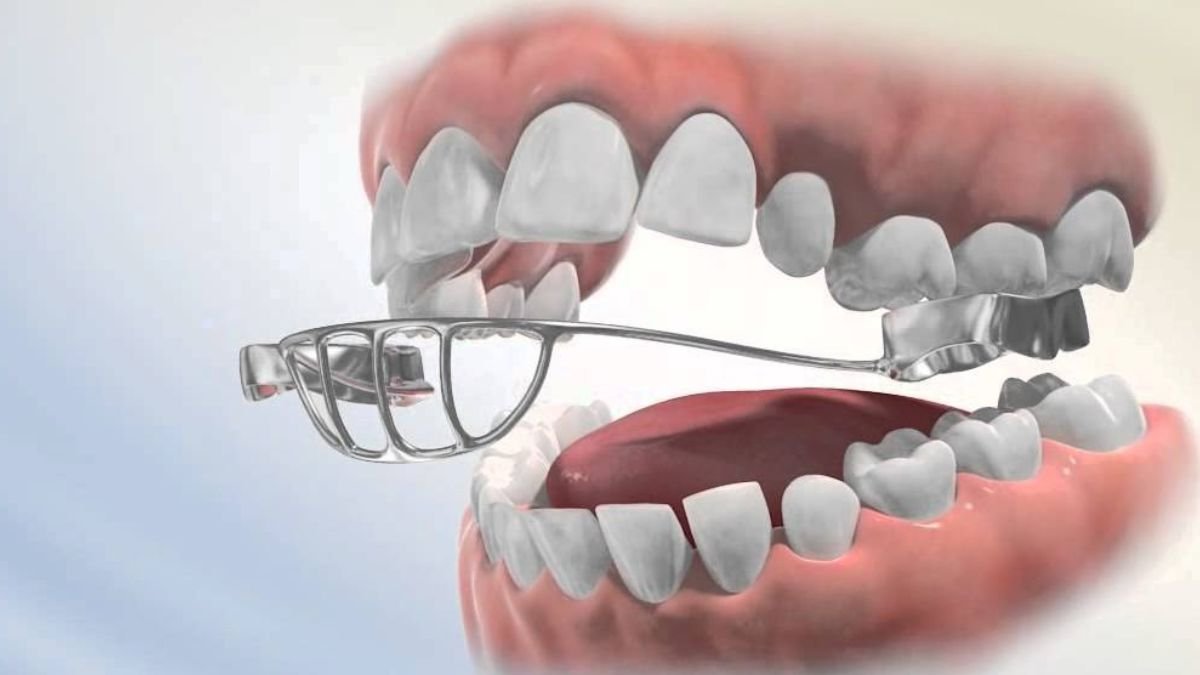Health
What Is a Tongue Crib?

Welcome to the world of dental care innovation! Today, we’re diving into the fascinating realm of tongue cribs. If you’ve ever wondered what a tongue crib is and how it can benefit you or your loved ones, you’re in for an enlightening read. Get ready to uncover the secrets behind this tiny yet mighty device that plays a significant role in oral health. Let’s explore the ins and outs of tongue cribs together!
How a tongue crib works
When it comes to understanding how a tongue crib works, it’s essential to grasp its primary function. A tongue crib is a dental appliance designed to discourage harmful habits like thumb sucking or tongue thrusting by creating discomfort when these actions are attempted.
The design of the tongue crib typically involves metal wires that are attached to bands on the back molars, forming a barrier that prevents the tongue from pushing against the front teeth. This impediment makes it uncomfortable and nearly impossible for individuals to engage in detrimental oral habits.
By disrupting the muscle movements involved in thumb sucking or tongue thrusting, a tongue crib helps retrain proper oral posture and promotes healthier alignment of teeth and jaw development over time. It essentially acts as a gentle reminder for the mouth to stay in an optimal position for growth and development.
Uses and benefits of a tongue crib
Tongue cribs play a crucial role in orthodontics by helping correct tongue posture and positioning. By limiting the movement of the tongue, a tongue crib assists in correcting issues like thumb sucking, open bites, and improper swallowing patterns. This device aids in guiding proper growth and alignment of the teeth and jaw.
One key benefit of using a tongue crib is its ability to prevent harmful habits that can impact dental development. It encourages nasal breathing over mouth breathing, which is essential for overall oral health. Additionally, a well-positioned tongue can contribute to improved speech clarity and reduce snoring or sleep apnea symptoms.
For individuals with specific orofacial conditions such as an incorrect resting tongue position or excessive anterior posture, a tongue crib may be recommended by their orthodontist or dentist. By addressing these issues early on with a tailored treatment plan involving a tongue crib, long-term oral health outcomes can be significantly improved.
Who needs a tongue crib?
Who might benefit from using a tongue crib? Well, individuals who struggle with persistent thumb sucking or tongue thrusting habits could find a tongue crib to be helpful. Children or adults dealing with issues like open bites, speech impediments caused by improper tongue placement, or dental misalignment due to these oral habits may also benefit from using a tongue crib.
It’s important to note that the decision to use a tongue crib should always be made in consultation with a qualified healthcare professional. They can assess the specific needs of each individual and determine if a tongue crib is an appropriate treatment option based on their unique circumstances and oral health goals.
The goal of using a tongue crib is to help retrain the muscles of the mouth and promote proper alignment of teeth and jaws over time.
Different types of tongue cribs
When it comes to tongue cribs, there are various types available to cater to different needs. One common type is the fixed tongue crib, which is permanently attached to the upper teeth. This design helps prevent tongue thrusting by creating a barrier that restricts the forward movement of the tongue during swallowing and speech.
Another type is the removable tongue crib, which can be taken out for cleaning or specific activities like eating. This option offers flexibility and convenience for those who may not need constant restriction on their tongues but still benefit from occasional use.
There are also adjustable tongue cribs that allow for customization based on individual preferences and requirements. These versatile devices can be tailored to fit comfortably in the mouth while effectively addressing specific oral issues.
Choosing the right type of tongue crib depends on factors like personal comfort, treatment goals, and dental recommendations. It’s essential to consult with a healthcare professional or orthodontist to determine the most suitable option for your unique situation.
The process of getting a tongue crib
When considering getting a tongue crib, the first step is to consult with a dentist or orthodontist specialized in orthodontic appliances. During this initial consultation, the professional will assess your specific needs and determine if a tongue crib is the right option for you or your child.
If it’s decided that a tongue’crib is suitable, the next step typically involves taking impressions of the teeth. These impressions help in custom-fitting the appliance to ensure comfort and effectiveness. Once the tongue’crib is fabricated, another visit to the dental office will be necessary for its placement.
The installation process usually involves bonding the tongue’crib to certain teeth using dental cement. The professional will provide instructions on how to care for and adjust to wearing the appliance. Regular follow-up appointments may also be scheduled to monitor progress and make any necessary adjustments along the way.
Potential risks and complications
When considering a tongue’crib, it’s essential to be aware of potential risks and complications that may arise. One possible issue is discomfort or soreness in the mouth due to the presence of the device. Additionally, some individuals may experience difficulties with speech initially as their tongue adjusts to the crib.
There is also a risk of increased saliva production at the beginning, which can be bothersome but typically subsides over time as the body acclimates to the appliance. In rare cases, there could be allergic reactions to materials used in making the tongue’crib.
Proper care and maintenance of the tongue’crib are crucial in minimizing these risks. Regular cleaning and check-ups with your healthcare provider can help identify any issues early on and prevent more significant problems from occurring. Be sure to follow all instructions provided by your dentist or orthodontist for optimal results and safety while using a tongue crib.
Caring for a tongue crib
Caring for a tongue’crib is essential to ensure its effectiveness and your oral health. Regular cleaning is key; gently brush the crib with a soft toothbrush and rinse thoroughly after meals. Avoid sticky or hard foods that could damage the appliance.
Additionally, maintain good oral hygiene by brushing your teeth twice a day and flossing regularly. Keep an eye out for any signs of irritation or discomfort caused by the tongue’crib, and consult your orthodontist if needed.
It’s crucial to follow your orthodontist’s instructions on how long to wear the tongue’crib each day. Consistency is key in achieving the desired results, so make sure to wear it as prescribed.
Store your tongue’crib in its case when not in use to prevent loss or damage. By taking care of your tongue’crib properly, you can maximize its benefits and help improve any underlying issues effectively.
Alternatives to a tongue crib
When it comes to alternatives to a tongue’crib, there are a few options that individuals can explore. One alternative is myofunctional therapy, which focuses on retraining the muscles of the mouth and tongue to improve function and alignment. This therapy can help address underlying issues causing tongue thrust or improper swallowing patterns.
Another alternative is orthodontic treatment, which may involve braces or other devices to correct tooth positioning and bite issues that could be contributing to the need for a tongue crib. Orthodontic intervention can sometimes alleviate the need for a tongue’crib by addressing the root cause of the problem.
Speech therapy is also an alternative worth considering for those experiencing speech difficulties related to tongue placement or movement. Speech therapists can work with individuals on exercises and techniques to improve articulation and overall speech clarity without the use of a tongue’crib.
Conclusion: Is a tongue crib right for you or your child?
Is a tongue’crib the right choice for you or your child? The decision to use a tongue’crib should be made in consultation with a qualified healthcare professional. If issues like tongue thrusting or thumb sucking are affecting oral health and development, a tongue’crib may offer an effective solution. However, it’s essential to weigh the benefits against any potential risks and consider alternative treatments if necessary.
Remember that proper care and maintenance of the tongue’crib are crucial for its effectiveness and your overall oral health. Regular check-ups with your dentist or orthodontist can help ensure that the device is working as intended.
While a tongue’crib can be a valuable tool in addressing certain oral habits and conditions, it’s important to seek professional guidance to determine if it is the right option for you or your child. Make an informed decision based on expert advice and personalized treatment recommendations for optimal results in improving oral function and alignment.
Health
The Vital Role of Electrical Equipment Testing in Modern Industry

The Importance of Electrical Equipment Testing
Maintaining high safety and operational standards in today’s fast-paced industrial landscape cannot be overstated. Electrical equipment testing is the cornerstone of this mission, providing a framework for ensuring that machinery is efficient and safe. Implemented routinely, comprehensive testing can identify potential failures before they become catastrophic problems, thereby safeguarding the work environment against possible risks. Companies looking to deepen their understanding of this critical process would benefit from exploring Divergent Alliance electrical equipment testing service. Their expertise thoroughly examines how effective testing can prevent operational disruptions and ensure a secure workplace. These insights provide practical knowledge and equip industries with the means to ensure comprehensive safety.
Standard Testing Methods and Techniques
When delving into electrical equipment testing, it becomes evident that various methods and techniques are employed to assess machinery reliability. Insulation testing, for example, is a common practice that analyzes the robustness and integrity of insulation materials within the equipment. By identifying weaknesses in insulation, this method helps prevent dangerous incidents such as short circuits and electrical fires.
Another crucial technique involves thermal imaging, a noninvasive method that detects hotspots within electrical systems. By capturing thermal anomalies, technicians can identify and resolve issues like overloaded circuits or loose connections, ensuring smooth operation. These methods are invaluable in extending equipment lifespan and maintaining peak performance, illustrating their essential role in industrial maintenance strategies.
Ensuring Safety and Compliance Through Testing
Adhering to safety and compliance standards is a key responsibility for industries worldwide. Electrical equipment testing ensures that all machinery operates within the set guidelines and regulations. These measures are not just about avoiding legal penalties; they also protect the workforce by providing a safe and reliable work environment.
When compliance is prioritized, it not only boosts the company’s reputation but also elevates employee morale and confidence. By maintaining stringent testing schedules, businesses demonstrate a dedication to safety and quality, which can beneficially influence their market presence and operational efficiency.
Preventing Downtime and Failures
Unexpected equipment downtime can be costly in industrial operations. When machines fail without warning, it can lead to unplanned delays, increased repair costs, and sometimes a complete standstill of operations. These risks can be substantially mitigated by proactively engaging in regular electrical equipment testing.
Routine testing helps pinpoint areas of concern before they escalate into full-fledged failures. This preventive approach allows companies to implement timely interventions, ensuring that machinery remains in top working condition. As a result, businesses experience increased productivity and reduced maintenance expenses, underscoring the value of an effective testing regimen.
Standards and Certifications in Testing
The significance of international standards and certifications such as ISO cannot be underestimated in electrical equipment testing. These certifications provide a benchmark for safety and quality, promoting uniformity and reliability across testing procedures globally. For organizations, achieving ISO certification enhances operational efficiency and boosts their credibility in industry circles.
The ISO news section offers abundant resources for individuals eager to explore these international standards. This resource is invaluable for professionals seeking a comprehensive understanding of how these standards impact operational and safety protocols.
Technological Advancements in Equipment Testing
Recent technological advancements have transformed the field of electrical equipment testing. Innovations such as automated testing systems and AI-powered diagnostics have redefined the precision and efficiency of testing practices. This shift enhances accuracy and speeds up the process, making testing more reliable and cost-effective.
Employing cutting-edge technologies allows companies to detect issues that traditional methods might overlook. This progressive approach to equipment maintenance represents a leap forward, focusing on precision and speed.
Frequently Asked Questions
- What is the primary purpose of electrical equipment testing? – It ensures the safety and efficiency of equipment in industrial settings, preventing potential hazards and inefficiencies.
- How often should equipment testing be conducted? – The frequency of testing hinges on industry-specific regulations and operational needs, but a regular schedule is generally advisable to maintain reliability.
- Are technological advancements affecting testing methods? – Absolutely. Current advancements in automation and AI have significantly improved the precision and speed of testing methods, enhancing reliability.
Health
The Benefits of Massage Therapy for Mind and Body Well-being

Introduction to Massage Therapy
Historically, massage therapy was synonymous with luxury, accessible primarily to those in exclusive wellness circles. However, as contemporary society acknowledges the importance of holistic health, massage therapy is becoming a mainstream option for enhancing well-being. It involves systematically manipulating soft tissues in the body to reduce pain, improve circulation, and afford a sanctuary from life’s pressures. Despite its traditional roots, modern massage therapy is an evolving field, continually embracing new techniques and understanding their multifaceted benefits. In a world filled with stress and relentless demands, unwinding is essential for maintaining physical and mental health. An excellent method to decompress and revitalize is through massage treatment. Massage is increasingly acknowledged as a critical part of an all-encompassing health plan, not simply a luxury. Whether exploring techniques at home or scheduling a session at a Napa spa, understanding massage therapy’s vast benefits can profoundly enhance your well-being.
This comprehensive guide delves into the extensive benefits of massage therapy, demonstrating its impact on the body and mind. Massage therapy provides a holistic approach to health that can speed up your wellness journey, from improved circulation to stress relief.
Understanding the Physical Benefits
Massage therapy has become widely recognized because of its potent effects on physical recovery and ability to relieve muscular tension effectively. In addition to its calming benefits, massage increases blood flow, which provides muscular tissues with vital nutrients and oxygen. This improved circulation accelerates the healing process, helping individuals recover more quickly from injuries, surgeries, or intense physical activity. According to scientific research, frequent massage treatment can also lessen lactic acid accumulation and inflammation, which promotes long-term muscular health. For people with chronic pain conditions like fibromyalgia or lower back pain, massage is a non-invasive, drug-free method of finding relief. Furthermore, massage treatment improves range of motion and flexibility while decreasing muscular stiffness, which is particularly beneficial for athletes or those with physically demanding schedules. Its preventive benefits are equally notable, helping to reduce the risk of future injuries by keeping muscles supple and joints mobile.
Mental Health and Relaxation
While the physical benefits of massage treatment are well established, its impact on mental health is as noteworthy. Engaging in regular massage sessions can significantly decrease cortisol levels, the hormone intricately linked with stress. As such, massage induces a state of relaxation and mental clarity, assisting in the reduction of anxiety symptoms and mild depression. According to Mayo Clinic studies, massage therapy facilitates relaxation and positively influences mood and emotional well-being, offering a non-invasive supplement to traditional treatment.
Different Types of Massage Techniques
Massage therapy encompasses various techniques, each tailored to distinct needs and preferences. Swedish massage’s gentle, calming strokes make it perfect for those seeking relaxation and stress relief. Deep tissue massage, on the other hand, relieves chronic pain and stress by focusing on deeper layers of muscle and connective tissue. Other methods, like aromatherapy and hot stone massage, combine different components to create distinctive sensory experiences that heighten the therapeutic benefits of massage.
Choosing the Right Massage for You
Selecting the appropriate massage therapy involves several considerations, including physical health, pain tolerance, and personal preferences. It’s advisable to consult with a wellness expert or therapist who can guide you based on your specific health and wellness objectives. For those uncertain about where to begin, resources like WebMD’s guide on massage types and benefits offer valuable insights into aligning your goals with the most suitable massage techniques, ensuring a beneficial experience tailored to your needs.
DIY Massage Techniques for Home Use
While professional massage therapy offers comprehensive benefits, integrating simple DIY techniques into your daily routine can also be advantageous. Tools such as foam rollers or massage balls effectively manage neck, shoulders, and back tension. These accessible methods enhance relaxation and contribute to daily stress management, providing relief from the comfort of your home.
Potential Risks and Precautions
Although massage therapy is generally safe, it may not suit everyone. Individuals with specific conditions, such as blood clots, fractures, or vascular issues, should proceed cautiously. It is crucial to communicate any existing health concerns with a qualified massage therapist to tailor sessions safely and effectively. To maximize the advantages of massage treatment while lowering any possible hazards, it is crucial to have a thorough awareness of one’s current health.
Conclusion
Incorporating massage therapy into your wellness strategy offers extensive benefits, making it an invaluable tool for achieving holistic health. Whether for relaxation or physical rejuvenation, massage therapy can substantially improve both body and mind well-being. By selecting the proper techniques and staying informed, massage becomes a powerful ally on the path to optimal health, supporting each individual’s journey toward greater balance and serenity.
Health
The Scientific Role of Research Peptides in Advancing Biotechnology

Introduction to Research Peptides
Research peptides, comprised of short chains of amino acids, are pivotal tools in biotechnology. These versatile molecules have opened doors to uncovering the mysteries of biological processes, allowing scientists to mimic natural functions and explore the complex interactions within cellular environments. Their significance is underscored by the increasing demand for premium research peptides for scientific studies, which offer high purity and precise configurations tailored to specific research needs. The beauty of peptides lies in their simplicity, married with complexity. On one hand, they are basic constructs made from naturally occurring building blocks. On the other hand, their multifaceted ability to interact specifically with biological systems allows them to act as catalysts and indicators in myriad studies. This duality makes them highly sought after for foundational research and innovative applications, ensuring they remain at the forefront of scientific exploration across various disciplines.
The biological relevance of research peptides is immense, as they enable the study of proteins and enzymes in their native-like forms. This aspect is crucial for understanding how proteins operate within living organisms and how malfunctions can lead to disease. Peptides can be synthesized to possess particular structures and functionalities, allowing scientists to investigate phenomena ranging from simple ligand-binding events to complex cellular signaling pathways.
How Research Peptides Are Paving the Way for Scientific Discoveries
Embracing the versatility of research peptides is transforming the landscape of scientific research. Their adoption has led to unprecedented breakthroughs across the health and biotechnology fields. By acting as modulators or inhibitors of specific pathways, peptides facilitate a deeper understanding of disease mechanisms at a molecular level, which is crucial for developing novel therapeutic strategies. Their contribution to regenerative medicine highlights the role of peptides in guiding scientific breakthroughs. In regenerative medicine, peptides are pivotal in elucidating the factors that promote tissue repair and organ regeneration. By studying peptides involved in signaling pathways that govern stem cell proliferation and differentiation, researchers aim to develop therapies that stimulate the natural regenerative processes.
Moreover, the application of peptides in vaccine development is another area in which they have had a significant impact. Peptides are increasingly employed in designing new vaccines that stimulate stronger immune responses with fewer side effects. By identifying and isolating specific epitopes, the portions of antigens recognized by the immune system, peptides allow for the creation of highly targeted vaccines. This precision enhances vaccine efficacy and minimizes the risk of adverse reactions, making peptide-based vaccines a promising avenue for addressing future public health challenges.
The Synthesis and Design of Research Peptides
The synthesis of research peptides is a hallmark of modern biochemical techniques, drawing on advancements in organic chemistry and molecular biology. The solid-phase peptide synthesis (SPPS) method is at the core of peptide synthesis, a revolutionary approach that has enabled the rapid and efficient production of peptides with precise sequences. SPPS involves sequentially adding amino acids to an expanding peptide chain attached to a solid substrate, enabling several reactions simultaneously in one vessel, thus minimizing contamination and maximizing yield. Designing peptides involves a nuanced understanding of the desired biological target and the biochemical properties requisite for effective interaction. Scientists employ computer-aided design techniques to model and predict peptide structures and interactions. This iterative process often involves tailoring peptide properties, such as charge, hydrophobicity, and secondary structure, to enhance stability and interaction specificity.
The design and synthesis process has challenges, as achieving the desired conformation and functionality can be complex. Researchers must navigate issues such as solubility, aggregation, and peptide degradation. They frequently employ modifications, such as incorporating non-natural amino acids or cyclization, to stabilize the peptides and enhance their bioavailability. These modifications are crucial for extending the utility of peptides in diverse research settings, from in vitro experiments to in vivo applications.
Applications in Biotechnology: A Closer Look
Biotechnology is a field ripe with innovation, and research peptides are pivotal in driving these advancements. They are integral to pharmaceutical development, offering a pathway to creating drugs with high specificity. Unlike traditional small-molecule drugs, peptides can precisely target specific receptors involved in disease processes, reducing off-target effects and improving therapeutic outcomes. This specificity makes peptide therapeutics a promising solution for treating complex diseases. Beyond therapeutics, peptides have found a niche in diagnostic applications. Their use in developing biosensors and diagnostic assays allows for unparalleled accuracy in detecting disease biomarkers. Peptide-based biosensors often exhibit rapid response times and high sensitivity. They are invaluable tools for early disease detection and monitoring, particularly in personalized medicine, where individual patient markers are critical.
Additionally, peptides are used in agricultural biotechnology to create plants with enhanced durability against pests and diseases. By leveraging peptides that mimic natural plant defense signals, scientists are engineering crops that can better withstand environmental stresses. This eco-friendly approach promotes sustainable agriculture by reducing the reliance on chemical pesticides, benefiting the environment, and supporting global food security efforts.
Challenges in Peptide Research
Despite peptides’ vast potential, researchers face substantial challenges in bringing peptide-based solutions to fruition. One significant hurdle is peptide stability; peptides are inherently susceptible to enzymatic degradation once administered into biological systems. This rapid breakdown limits their bioavailability and therapeutic efficacy. Researchers are exploring various strategies to protect peptides from premature degradation, such as chemical modifications and alternative peptide delivery systems. Another obstacle is the high cost of peptide synthesis, which can be prohibitively expensive when scaling up for industrial applications. Researchers are focused on optimizing synthesis protocols and developing new technologies to reduce production costs without sacrificing quality. Advances in peptide synthesis automation and exploring alternative synthesis materials pave the way for more cost-effective production methods.
The challenges of peptide research also extend to regulatory hurdles. Developing peptides for therapeutic use requires navigating stringent regulatory frameworks that ensure safety and efficacy. This procedure may require significant time and resources, creating an additional barrier to market entry. However, continued collaboration between researchers, regulatory bodies, and industry stakeholders is essential to streamline these pathways and bring peptide innovations to market.
The Future of Peptide Research
As research continues to evolve, the future of peptide studies promises exciting advancements that could revolutionize biotechnology and medicine. Cutting-edge techniques such as high-throughput screening and peptide library generation are accelerating the discovery of novel peptides with unique properties. These techniques allow scientists to rapidly evaluate thousands of peptide variants, identifying those with optimal characteristics for targeted applications. Emerging technologies are set to transform peptide research. By analyzing large datasets from peptide studies, these technologies can reveal previously hidden patterns and relationships, offering insights into peptide functionality and informing the design of new peptide therapeutics. These computational approaches enhance the efficiency and precision of peptide research, potentially significantly shortening the development timeline for peptide-based interventions.
Moreover, peptide integration with other emerging technologies, such as nanotechnology, can create novel delivery systems that enhance peptide stability and targeting capabilities. For instance, using nanoparticles to encapsulate peptides can extend their half-life and improve cellular uptake. It opens new avenues for peptide-based therapies that effectively reach their intended targets within the body.
Ethical Considerations in Peptide Studies
As with any scientific endeavor, ethical considerations are paramount in peptide research. Responsible research conduct ensures that advancements are made with respect for safety, environmental impact, and societal benefit. Ethical challenges arise in clinical testing, where the balance between innovation and patient safety must be carefully managed. Researchers must follow stringent ethical standards to safeguard participants and ensure transparency in reporting findings. Beyond human applications, using peptides in agriculture and environmental science necessitates ethical scrutiny. Assessing the long-term impacts of peptide applications on ecosystems and biodiversity is crucial, ensuring that biotechnological interventions promote sustainability and ecological health. Public engagement and interdisciplinary collaboration are essential in addressing these ethical concerns and fostering an informed dialogue on the implications of peptide research. The ethical landscape of peptide studies is complex, requiring ongoing evaluation and adaptation as new technologies and applications emerge. The scientific community must stay alert in its commitment to ethical integrity, continually revisiting policies and practices to ensure that research contributes positively to society while mitigating potential risks.
Conclusion
In conclusion, research peptides are at the forefront of biotechnology innovation, offering unprecedented opportunities to explore and exploit biological processes. Despite the challenges accompanying their study and application, the potential benefits of peptide research are vast, promising new therapies, diagnostics, and sustainable solutions across diverse fields. As science progresses, a continued commitment to overcoming challenges and adhering to ethical standards will be essential in fully realizing the potential of peptides. By fostering collaboration and innovation, researchers can harness the power of peptides to drive meaningful advances that enhance human health and environmental sustainability.
-

 Entertainment12 months ago
Entertainment12 months agoSandra Orlow: Exploring the Life and Legacy of a Cultural Icon
-

 General8 months ago
General8 months agoBaby Alien Fan Bus: Watch Parts 2 & 3 on Twitter, Reddit!
-

 General8 months ago
General8 months agoDiana Nyad & Bart Springtime: A Swim to Success
-

 Business1 year ago
Business1 year agoTex9.Net Crypto: Fast, Secure International Money Transfers with Competitive Rates
-

 Business1 year ago
Business1 year agoWhat is O Farming: How to Make Money Online and Its Start-Up Benefits
-

 Business1 year ago
Business1 year agoSnapchat Planets: Exploring Your Streak Universe
-

 General11 months ago
General11 months agoDeeper Dive into myfavouriteplaces. org:// blog
-

 Business1 year ago
Business1 year agoFintechZoom Apple Stock: Real-Time Insights and Expert Analysis
